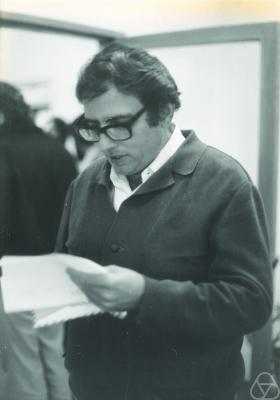In mathematics, especially in functional analysis, the Tsirelson space is the first example of a Banach space in which neither an ℓ p space nor a c0 space can be embedded. The Tsirelson space is reflexive.

Roger Godement was a French mathematician, known for his work in functional analysis as well as his expository books.
In functional analysis and related areas of mathematics, a barrelled space is a topological vector space (TVS) for which every barrelled set in the space is a neighbourhood for the zero vector. A barrelled set or a barrel in a topological vector space is a set that is convex, balanced, absorbing, and closed. Barrelled spaces are studied because a form of the Banach–Steinhaus theorem still holds for them. Barrelled spaces were introduced by Bourbaki.
Czesław Ryll-Nardzewski was a Polish mathematician.
In mathematics, Choquet theory, named after Gustave Choquet, is an area of functional analysis and convex analysis concerned with measures which have support on the extreme points of a convex set C. Roughly speaking, every vector of C should appear as a weighted average of extreme points, a concept made more precise by generalizing the notion of weighted average from a convex combination to an integral taken over the set E of extreme points. Here C is a subset of a real vector space V, and the main thrust of the theory is to treat the cases where V is an infinite-dimensional topological vector space along lines similar to the finite-dimensional case. The main concerns of Gustave Choquet were in potential theory. Choquet theory has become a general paradigm, particularly for treating convex cones as determined by their extreme rays, and so for many different notions of positivity in mathematics.
In mathematics, a vector measure is a function defined on a family of sets and taking vector values satisfying certain properties. It is a generalization of the concept of finite measure, which takes nonnegative real values only.
In the mathematical field of functional analysis, the Eberlein–Šmulian theorem is a result that relates three different kinds of weak compactness in a Banach space.

Joram Lindenstrauss was an Israeli mathematician working in functional analysis. He was a professor of mathematics at the Einstein Institute of Mathematics.
In mathematics, Auerbach's lemma, named after Herman Auerbach, is a theorem in functional analysis which asserts that a certain property of Euclidean spaces holds for general finite-dimensional normed vector spaces.
In mathematics — specifically, in functional analysis — an Asplund space or strong differentiability space is a type of well-behaved Banach space. Asplund spaces were introduced in 1968 by the mathematician Edgar Asplund, who was interested in the Fréchet differentiability properties of Lipschitz functions on Banach spaces.
John Rolfe Isbell was an American mathematician. For many years he was a professor of mathematics at the University at Buffalo (SUNY).
Beginning in 1974, the fictitious Peter Orno appeared as the author of research papers in mathematics. According to Robert Phelps, the name "P. Orno" is a pseudonym that was inspired by "porno", an abbreviation for "pornography". Orno's short papers have been called "elegant" contributions to functional analysis. Orno's theorem on linear operators is important in the theory of Banach spaces. Research mathematicians have written acknowledgments that have thanked Orno for stimulating discussions and for Orno's generosity in allowing others to publish his results. The Mathematical Association of America's journals have also published more than a dozen problems whose solutions were submitted in the name of Orno.

Robert Ralph Phelps was an American mathematician who was known for his contributions to analysis, particularly to functional analysis and measure theory. He was a professor of mathematics at the University of Washington from 1962 until his death.

Claude Ambrose Rogers FRS was an English mathematician who worked in analysis and geometry.
Hans Vilhem Rådström (1919–1970) was a Swedish mathematician who worked on complex analysis, continuous groups, convex sets, set-valued analysis, and game theory. From 1952, he was lektor at Stockholm University, and from 1969, he was Professor of Applied Mathematics at Linköping University.

Isaac Namioka was a Japanese-American mathematician who worked in general topology and functional analysis. He was a professor emeritus of mathematics at the University of Washington. He died at home in Seattle on September 25, 2019.
Joseph Diestel was an American mathematician and Professor of Mathematics at Kent State University. In addition to his contribution to functional analysis, particularly Banach space theory and the theory of vector measures, Diestel was known for a number of highly influential textbooks: in 1975 he published "Lecture Notes Geometry of Banach Spaces—Selected Topics"; in 1977, he published "Vector Measures" with J. Jerry Uhl; in 1984, published "Sequences and series in Banach spaces" and in 1995 he published "Absolutely summing operators" with H. Jarchow and A. Tonge; as well as a number of other books.
In functional analysis, a discipline within mathematics, a locally convex topological vector space (TVS) is said to be infrabarrelled if every bounded barrel is a neighborhood of the origin.
In mathematics, particularly in functional analysis, the closed graph theorem is a result connecting the continuity of a linear operator to a topological property of their graph. Precisely, the theorem states that a linear operator between two Banach spaces is continuous if and only if the graph of the operator is closed.





